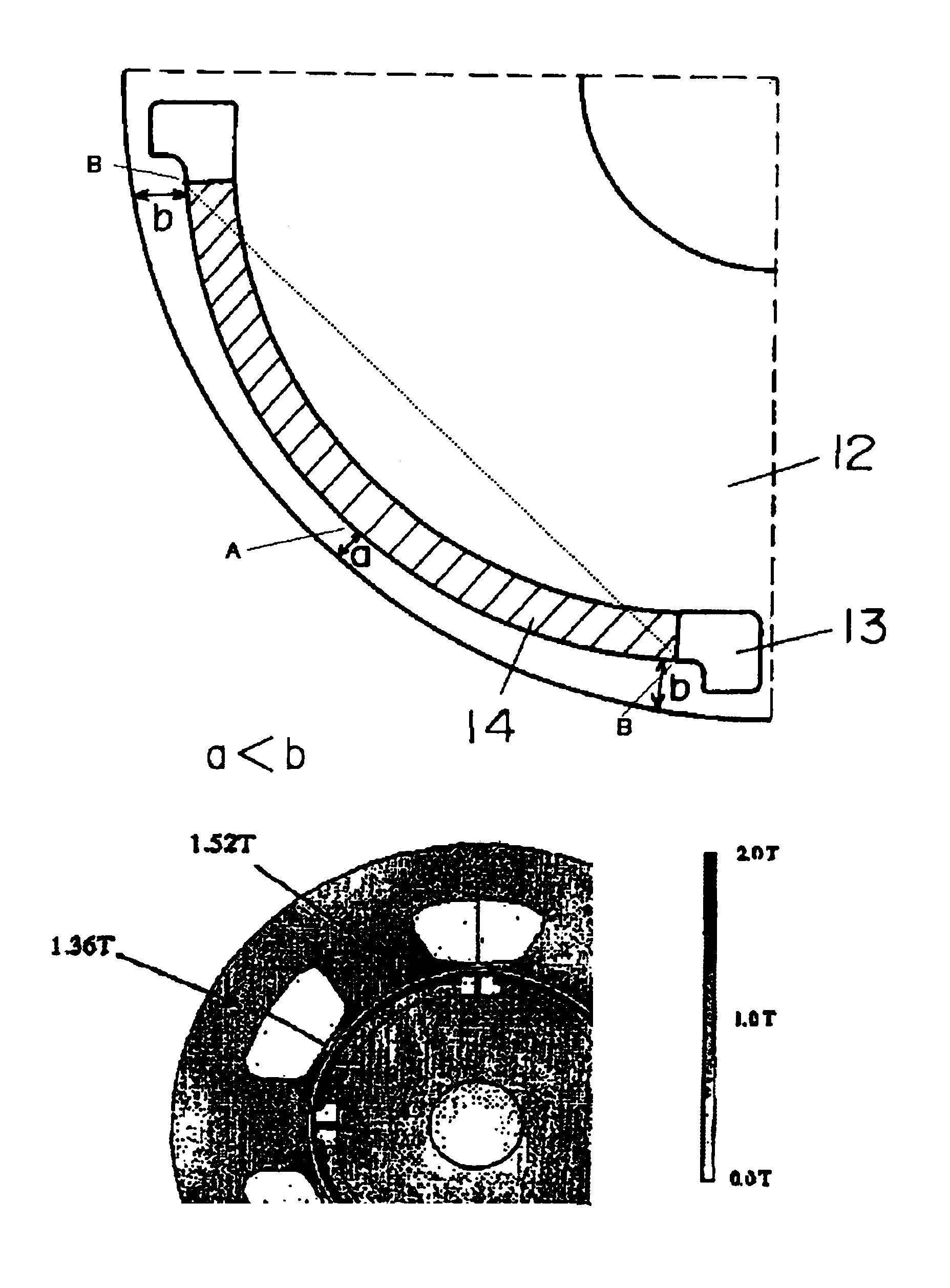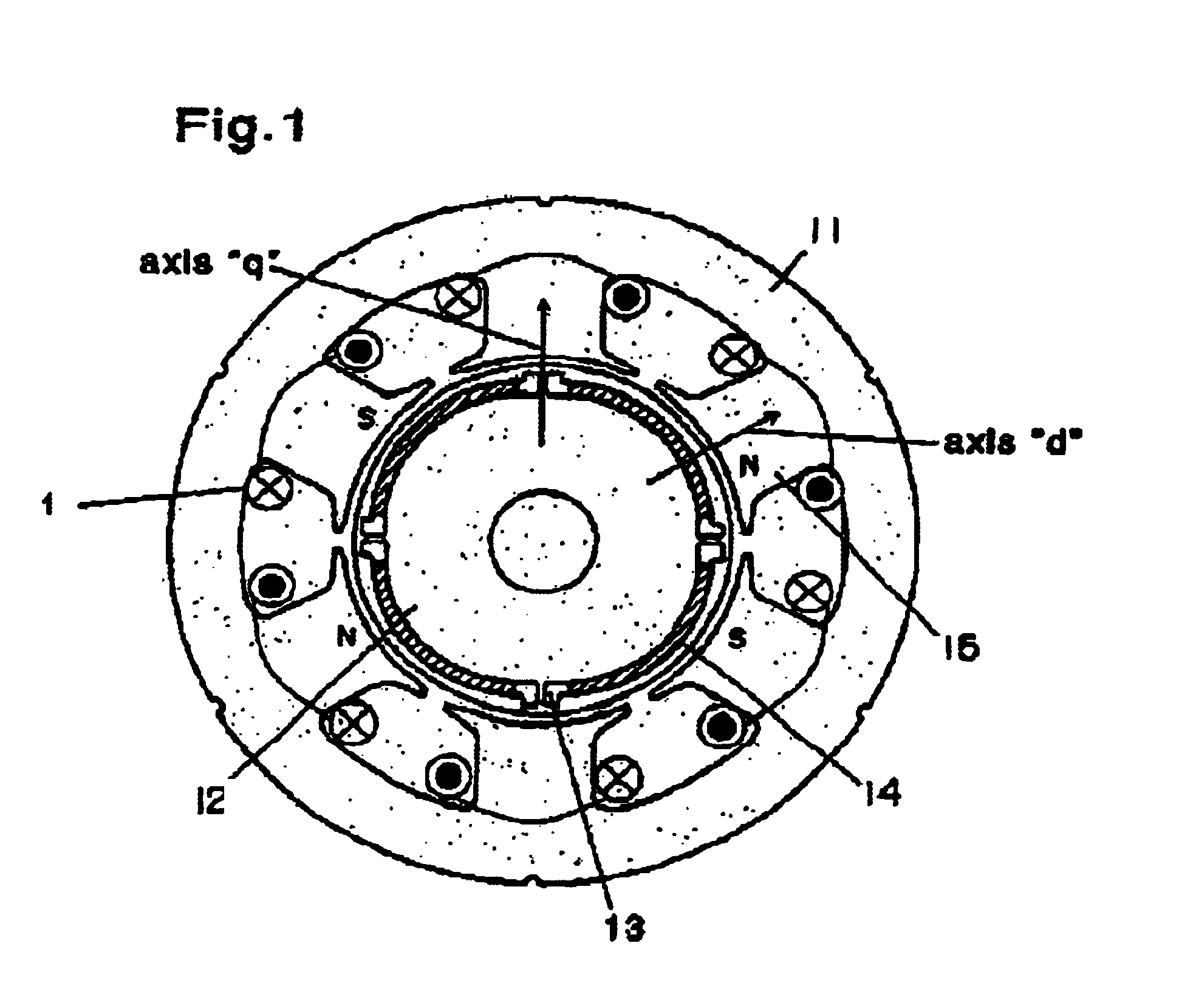Permanent magnet synchronous motor
a permanent magnet, synchronous motor technology, applied in the direction of rotating magnets, synchronous machines with stationary armatures, magnetic circuit rotating parts, etc., can solve the problems of reducing efficiency, reducing the advantage of concentrated windings, and greatly increasing iron loss, so as to reduce the density of magnetic flux of stator cores, less magnetic salient poles, and high efficiency
- Summary
- Abstract
- Description
- Claims
- Application Information
AI Technical Summary
Benefits of technology
Problems solved by technology
Method used
Image
Examples
exemplary embodiment 1
[0021]FIG. 1 illustrates the first exemplary embodiment, a structure is provided that includes a stator 11 employing concentrated windings 1, a rotor 12, slits 13, and permanent magnets 14 located in the slits. Stator 11 has three phases, four poles and six slots. Each one of teeth is wound independently with a winding, and two coils of each phase are apart 180 degrees from each other, i.e., opposite to each other. Stator 11 is formed by laminating plural electromagnetic steel sheets in a rotary shaft direction, and includes plural teeth. Ends of each one of teeth 15 slightly encroach into slots as shown in FIG. 3.
[0022]To be more specific, distance “r” between arc face 16, which faces to rotor 12, of stator 11 and the center of rotor 12 is smaller at a center portion of teeth 15 than at the end of teeth 15. (The broken line tangent to arc face 16 measures a constant distance “r” from the center of rotor 12.) This structure restrains demagnetizing field from flowing to rotor 12. Bec...
exemplary embodiment 2
[0029]FIG. 9 illustrates the second embodiment of the present invention. FIG. 9 illustrates a structure that includes a stator 21 that employs the concentrated windings 1, wherein V-shaped slits 23 are formed in a rotor 22, and wherein permanent magnets 24 are located in the slits 23. The vertex of each one of the V-shaped magnets faces toward the outside rim of the rotor. This structure also can narrow the flux path along axis “q” as discussed in the first embodiment, and thus can lower the iron loss. This structure produces a similar advantage to the first embodiment. Further, as shown in FIG. 9, the permanent magnet to be buried in each slit is divided in half, and two sheets of magnet shaped like a flat plate can be inserted into the slit. Thus an efficient motor of a lower cost, which uses inexpensive and flat magnets instead of expensive and arc-shaped magnets shown in FIG. 1, can be obtained.
[0030]The V-shaped magnet shown in FIG. 9 uses two sheets of permanent magnet in one ...
exemplary embodiment 3
[0031]FIG. 10 shows sectional view of a compressor which employs the synchronous motor having permanent magnets in accordance with the first exemplary embodiment. As shown in FIG. 10, the compressor comprises the stator 11 using the concentrated windings, rotor 12, the permanent magnets 14, an accumulator 31 and a compressing mechanism 32. The motor of this compressor has a shorter length including its coil end, and works efficiently, so that the compressor is best fit for a place where the power or the storage area is limited, such as an air-conditioner compressor C for an air-conditioning unit 104 for a vehicle 100, in particular an electric vehicle, for cooling a passenger compartment 102, as schematically illustrated in FIG. 10A.
PUM
 Login to View More
Login to View More Abstract
Description
Claims
Application Information
 Login to View More
Login to View More - R&D
- Intellectual Property
- Life Sciences
- Materials
- Tech Scout
- Unparalleled Data Quality
- Higher Quality Content
- 60% Fewer Hallucinations
Browse by: Latest US Patents, China's latest patents, Technical Efficacy Thesaurus, Application Domain, Technology Topic, Popular Technical Reports.
© 2025 PatSnap. All rights reserved.Legal|Privacy policy|Modern Slavery Act Transparency Statement|Sitemap|About US| Contact US: help@patsnap.com



